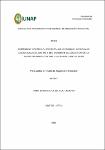Diversidad y potencial forestal de un bosque natural de colina baja del distrito del Yavarí en la concesión de la Industria Maderera SAC – sector B, Loreto, Perú
Abstract
El estudio se realizó en un bosque de colina baja del distrito del Yavari, Loreto, Perú. La parcela de corta anual (PCA) 9 sector B de la concesión de la empresa Industrial Maderera SAC, cuenta con un superficie de 500 ha de bosque. Los objetivos fueron, registrar la composición florística de las especies comerciales con diámetro 40 cm; determinar el IVI; determinar el volumen por clase diamétrica, definir el volumen de madera comercial en pie, valorar económica del bosque e identificar el uso actual y potencial de las especies comerciales registradas por ha y total. Se utilizó el diseño sistemático de fajas, el inventario al 100%, con 50 unidades de muestreo distribuidos sistemáticamente, utilizando parcelas rectangulares de 100 m x 1000 m; en cada unidad de muestreo se consideraron a todos los árboles comerciales con DAP 40 cm. Se encontraron 14 especies comerciales en 8 familias botánicas. Las familias Myristicaceae y Fabaceae tienen el mayor número de especies comerciales con tres especies cada uno (37% del total), seguidas de la familia Meliaceae con 2 especies comerciales y Bombacaceae, y Moraceae con 1 especie comercial cada una. Según el IVI, “cumala blanca”, “aguano cumala”, “cumala caupuri”, “tornillo” y “almendra” son las especies más representativas con 116% de participación en la estructura del bosque, mientras que “azúcar huayo” tiene poca participación con 8% de IVI. This study determined the diversity and potential of a natural low-hill forest situated in the 500-ha annual cut plot 9 sector B of the forest concession of the company Industrila Maderera SAC in the Yavari district, Loreto, Peru. The floristic composition of commercial species with DBH 40 cm; the IVI, the volume per diameter class, the standing commercial lumber volume were registered and then the economic value of the studied forest was calculated; also the current and potential use of commercial species were identified. A 100% inventory using a strip systematic design was carried out, 50 sampling units were systematically distributed and 100 m x 1000 m rectangular plots were used where all commercial trees with DBH 40 cm were recorded. 14 commercial species in eight botanical families were found. Myristicaceae and Fabaceae families have the highest number of 3 commercial species with each (37% of the total), followed by Meliaceae with 2 commercial species and Bombacaceae and Moraceae species with 1 commercial species each. According to the IVI, " cumala blanca", "aguano cumala", "cumala caupuri", "tornillo" and "almendra" are the most representative species with a share of 116% in the forest structure, while "azucar huayo " has little share with 8% of IVI.
Collections
- Tesis [526]
The following license files are associated with this item:


